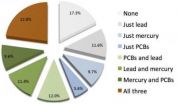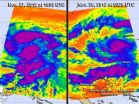(Press-News.org) WASHINGTON, November 28, 2012 – U.S. Department of Agriculture (USDA) scientists working as part of an international team have completed a "shotgun sequencing" of the wheat genome, a paper published in the journal Nature reported today. The achievement is expected to increase wheat yields, help feed the world and speed up development of wheat varieties with enhanced nutritional value.
"By unlocking the genetic secrets of wheat, this study and others like it give us the molecular tools necessary to improve wheat traits and allow our farmers to produce yields sufficient to feed growing populations in the United States and overseas," said Catherine Woteki, USDA's Chief Scientist and Under Secretary for Research, Education and Economics. "Genetics provides us with important methods that not only increase yields, but also address the ever-changing threats agriculture faces from natural pests, crop diseases and changing climates."
Olin Anderson and Yong Gu, scientists with USDA's Agricultural Research Service (ARS) based at the agency's Western Regional Research Center in Albany, Calif., played instrumental roles in the sequencing effort, along with Naxin Huo, a post-doctoral researcher working in Gu's laboratory. All three are co-authors of the Nature paper.
ARS is USDA's principal intramural scientific research agency, and the work supports the USDA goal of ensuring global food security.
As the world's largest agricultural research institute, USDA is focused on reducing global hunger by increasing global cooperation and collaboration on research strategies and their implementation. For example, through the U.S. government's Feed the Future initiative, USDA and the U.S. Agency for International Development (USAID) are coordinating their research portfolio with ongoing work of other donors, multilateral institutions, and government and non-government entities at the country level to effectively improve agricultural productivity, reduce food insecurity and generate economic opportunity.
Grown on more land area than any other commercial crop, wheat is the world's most important staple food, and its improvement has vast implications for global food security. The work to complete the shotgun sequencing of the wheat genome will help to improve programs on breeding and adaptation in Asia and Sub-Saharan Africa for wheat crops that could be drought tolerant and resistant to weeds, pests and diseases.
ARS is one of nine institutions with researchers who contributed to the study. The lead authors are based in the United Kingdom and were funded by the British-based Biotechnology and Biological Sciences Research Council. Funding also was provided by USDA's National Institute of Food and Agriculture (NIFA). NIFA focuses on investing in research, education and extension programs to help solve critical issues impacting people's daily lives.
The study represents the most detailed examination to date of the DNA that makes up the wheat genome, a crop domesticated thousands of years ago. The wheat genome is five times the size of the human genome, giving it a complexity that makes it difficult to study. The researchers used the whole genome shotgun sequencing approach, which essentially breaks up the genome into smaller, more workable segments for analysis and then pieces them together.
Another international team of scientists is working on a long-term project expected to result in more detailed sequencing results of the wheat genome in the years ahead. But the results published today shed light on wheat's DNA in a way that will help breeders develop hardier varieties by linking genes to key traits, such as disease resistance and drought tolerance.
Wheat evolved from three ancient grasses, and the ARS team, working closely with partners at University of California, Davis, mapped the genome of one of those three parents, Aegilops tauschii. That mapping, funded in part by the National Science Foundation, was instrumental in the study. It allowed researchers to identify the origins of many of the genes found in modern-day wheat, a key step in linking genes to traits and developing markers for use in breeding new varieties.
Wheat growers face numerous challenges each year. Acidity in the soil can make wheat difficult to grow in some areas. Stem rust, a fungal disease, can wipe out entire crops, and a particularly aggressive form of stem rust has developed the ability to knock out genetic resistance in many popular wheat varieties and is causing major losses overseas.
USDA scientists have conducted similar genomic studies that have helped to increase the productivity of dairy operations, enhance cattle breeding and improve varieties of a number of other crops, including tomatoes, corn and soybeans. In 2010, Anderson and Gu, along with other ARS staff, were part of a team that published a paper in Nature detailing the sequencing of Brachypodium distachyon, a model plant used to study wheat, barley and biofuel crops.
Recent international research collaborations have been critical to meet challenges such as combating wheat rust and increasing wheat productivity, fighting aflatoxin contamination in corn, and sequencing genomes of important crops.
INFORMATION:
The Nature paper can be found at: http://www.nature.com/nature/journal/v491/n7426/full/nature11650.html
USDA is an equal opportunity provider and employer. To file a complaint of discrimination, write: USDA, Office of the Assistant Secretary for Civil Rights, Office of Adjudication, 1400 Independence Ave., SW, Washington, DC 20250-9410 or call (866) 632-9992 (Toll-free Customer Service), (800) 877-8339 (Local or Federal relay), (866) 377-8642 (Relay voice users).
END
(SACRAMENTO, Calif.) — Amid increasing fear of overexposure to radiation from CT scans, a panel of experts has recommended more research on the health effects of medical imaging and ways to reduce unnecessary CT tests, as well as industry standardization of CT machines.
The recommendations, published in the November 2012 issue of Radiology, were developed at the Radiation Dose Summit, organized by the National Institute of Biomedical Imaging and Bioengineering (NIBIB). The summit included more than 100 medical physicists, radiologists, cardiologists, engineers, industry ...
MEDFORD/SOMERVILLE, Mass. (November 28, 2012) –Tufts University School of Engineering researchers have demonstrated silk-based implantable optics that offer significant improvement in tissue imaging while simultaneously enabling photo thermal therapy, administering drugs and monitoring drug delivery. The devices also lend themselves to a variety of other biomedical functions.
Biodegradable and biocompatible, these tiny mirror-like devices dissolve harmlessly at predetermined rates and require no surgery to remove them.
The technology is the brainchild of a research ...
A completely new method of manufacturing the smallest structures in electronics could make their manufacture thousands of times quicker, allowing for cheaper semiconductors. The findings have been published in the latest issue of Nature.
Instead of starting from a silicon wafer or other substrate, as is usual today, researchers have made it possible for the structures to grow from freely suspended nanoparticles of gold in a flowing gas.
Behind the discovery is Lars Samuelson, Professor of Semiconductor Physics at Lund University, Sweden, and head of the University's ...
PROVIDENCE, R.I. [Brown University] — Nearly 23 percent of American women of childbearing age met or exceeded the median blood levels for all three environmental chemical pollutants — lead, mercury, and PCBs — tracked in an analysis of data on thousands of women by Brown University researchers. All but 17.3 percent of the women aged 16 to 49 were at or above the median blood level for one or more of these chemicals, which are passed to fetuses through the placenta and to babies through breast milk.
The study, published in advance online Nov. 15 in the journal Environmental ...
KINGSTON, R.I. – November 28, 2012 – A team of archaeologists from the University of Rhode Island, the Israel Antiquities Authority, and the University of Louisville have discovered the remains of a fleet of early-19th century ships and ancient harbor structures from the Hellenistic period (third to first century B.C.) at the city of Akko, one of the major ancient ports of the eastern Mediterranean. The findings shed light on a period of history that is little known and point to how and where additional remains may be found.
The discoveries were presented on November ...
The diagnostic system used by many mental health practitioners in the United States -- known as the Diagnostic and Statistical Manual of Mental Disorders -- assumes that symptoms of two disorders that occur at the same time are additive and that the order in which the disorders are presented doesn't matter. But new research suggests that order actually plays a significant role in determining how clinicians think about psychiatric disorders.
In an article published in Clinical Psychological Science, a journal of the Association for Psychological Science, researchers Jared ...
Boulder, Colo., USA – Geosphere articles posted online 16 November 2012 cover a variety of topics, such as the geophysics of the Hogri fault zone, 5 km offshore of the Diablo Canyon nuclear power plant; using web-based GIS technologies and readily available global remote sensing datasets for investigations of arid land; the structure and evolution of the U.S. Sierra Nevada; the ANDRILL McMurdo Ice Shelf and Southern McMurdo Sound Drilling Projects; and climate-tectonic interactions in the southern Alaskan orogen.
Abstracts for these and other Geosphere papers are available ...
Tropical Storm Bopha continues to intensify in the western North Pacific Ocean as it heads toward Yap State, triggering more warnings and watches. Infrared imagery from NASA's Aqua satellite captured over two days revealed that the storm had consolidated, intensified and developed a large band of strong thunderstorms south of the center, that resemble a tail.
Infrared images of Tropical Storm Bopha were taken by the AIRS instrument on NASA's Aqua satellite on Nov. 27 at 1505 UTC when Bopha had maximum sustained winds near 45 mph, and on Nov. 28 at 0329 UTC when Bopha's ...
Data from NASA's Cassini spacecraft tie a shift in seasonal sunlight to a wholesale reversal, at unexpected altitudes, in the circulation of the atmosphere of Saturn's moon Titan. At the south pole, the data show definitive evidence for sinking air where it was upwelling earlier in the mission. So the key to circulation in the atmosphere of Saturn's moon Titan turned out to be a certain slant of light. The paper was published today in the journal Nature.
"Cassini's up-close observations are likely the only ones we'll have in our lifetime of a transition like this in action," ...
Berkeley — The primary source of light for more than a billion people in developing nations is also churning out black carbon at levels previously overlooked in greenhouse gas estimates, according to a new study led by researchers at the University of California, Berkeley, and the University of Illinois.
Results from field and lab tests found that 7 to 9 percent of the kerosene in wick lamps — used for light in 250-300 million households without electricity — is converted to black carbon when burned. In comparison, only half of 1 percent of the emissions from burning ...




